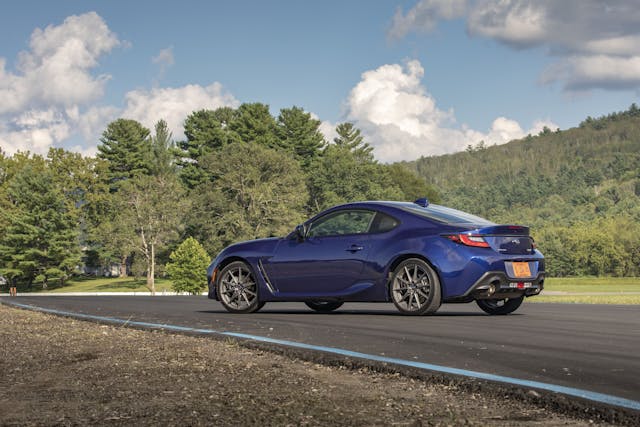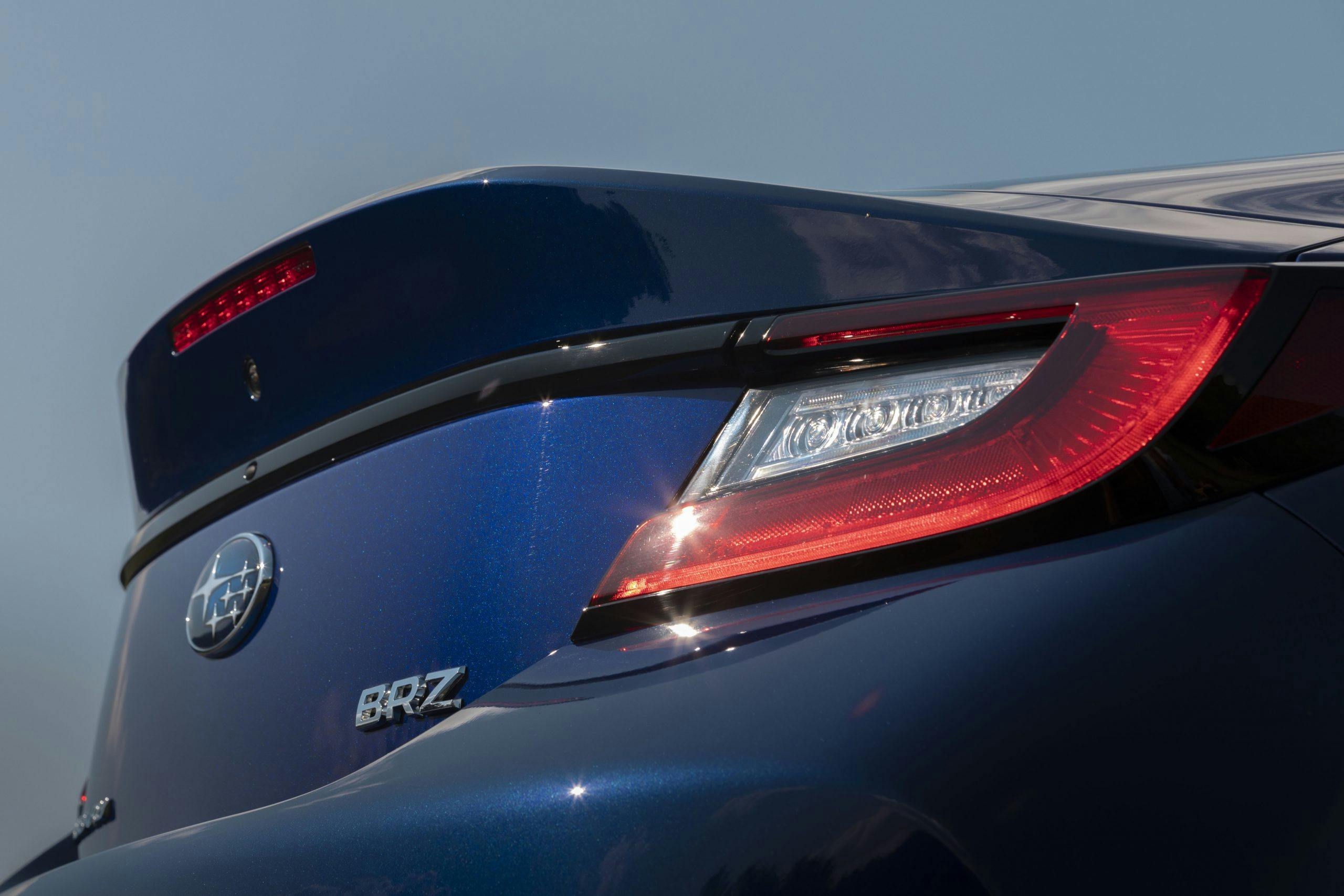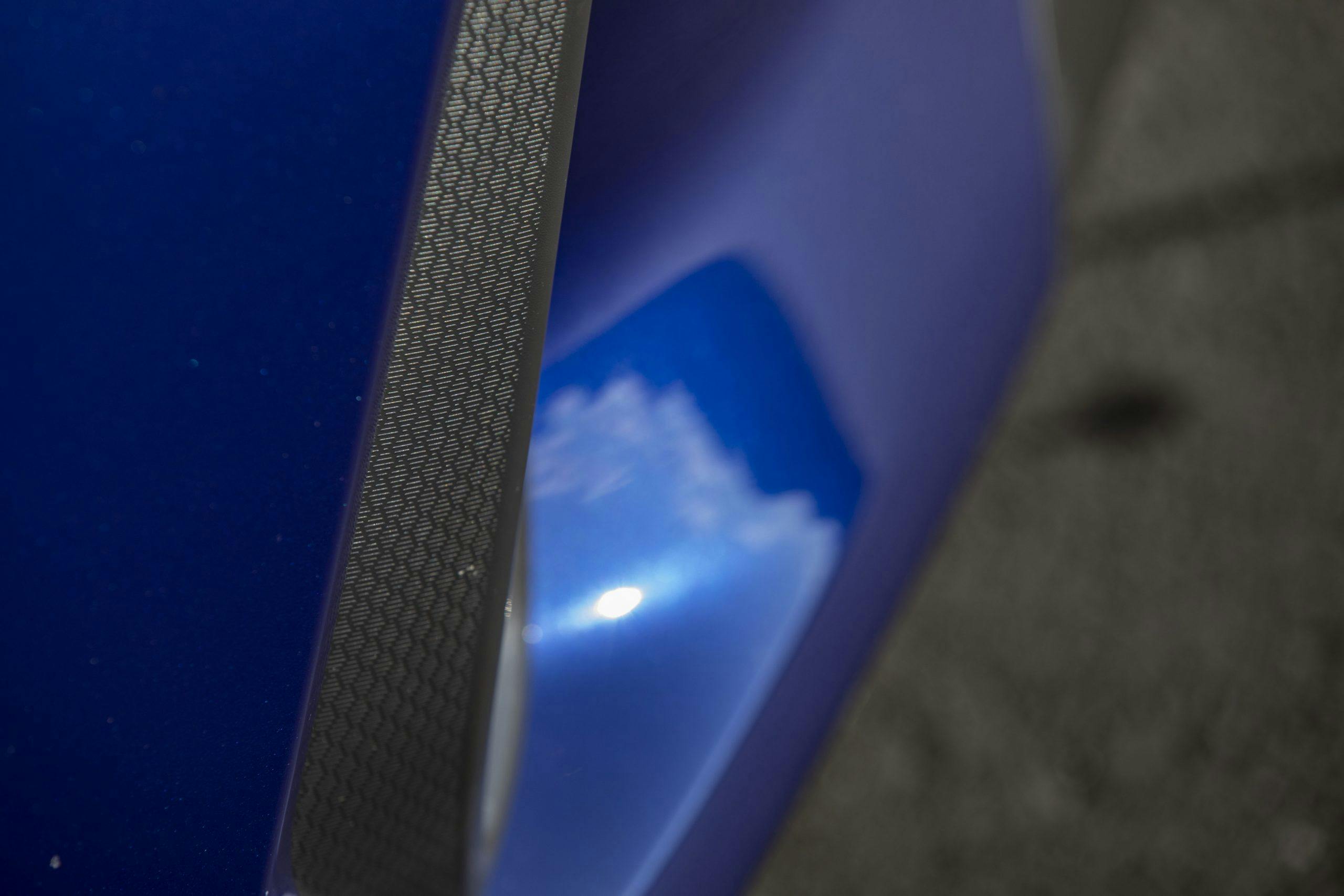First Look Review: 2022 Subaru BRZ
If you had a chance to race at Le Mans, wouldn’t you stick around and see the sights afterward? I had something even better planned: After running a low horsepower spec race car against 99 other competitors in a 5 hour support race on the Circuit de la Sarthe, I decided to immediately fly back to the States for a date with another car featuring relatively low horsepower and (I hoped) a similar fun factor. The new Subaru BRZ has a lot to live up to and I couldn’t help but think … gosh I hope they didn’t screw this up.
While I tend not to focus on the negative, I say that because the car’s first version is so fun and easy to drive that it would be easier to muck up that equation than to improve it. There have been 42,144 of them sold in the U.S. since it launched. Not bad for a sporting car in this country—and there’s the Toyota version as well, doing decent numbers in showrooms. Yes there are frequent requests for more horsepower and whistly boost noises from under the hood, but the car itself has been a riot to drive, as-is, from Day 1. Want more? The aftermarket has had you covered.
A notice to readers: Comments on new Hagerty articles have been disabled due to technical issues since July 29th. Don’t worry, the comments are coming back soon, and when they do, we’ll have a contest or giveaway to reward our readers for their patience. Never stop driving! — Jack Baruth

Now comes the updated BRZ, and the specs look good. Subaru answered the call for more power by utilizing a 2.4-liter normally aspirated boxer engine that provides 228 horsepower and 184 lb-ft of torque. The torque is higher and flatter across the rev range, with the mid-range dip that was sometimes complained about in the previous version being significantly reduced. No, there is not a turbo under the hood—but that’s okay as the nimble nature of the car could be affected when you add the weight of turbos, intercoolers, and other necessary equipment. The change from the 2.0-liter to 2.4-liter engine only added 20 pounds of weight to the car. Engineers were quick to combat that heft with an aluminum roof, prop shaft, fenders, muffler, and lighter seats.
So how does it perform? I had the opportunity to drive both the automatic and manual versions of the top-spec Limited trim model on the Lime Rock Park main circuit, autocross course, and public roads to and from our hotel. Our drive started in an automatic BRZ. This is a sports car with utility in mind, and the engineers made it a point to design around fitting four wheels, tools, and a helmet in the car for trips to track days. Even the TPMS now has two sets of wheels you can program and switch between via a button on the dashboard. Great for your street set and track set of tires … or for those that live in climates requiring a set of winters.


The seats are comfortable for a spirited drive on bumpy, curvy roads and as I found later on the track, very supportive and well-bolstered. As a nerd who everyday uses data on-track to improve performance, I can appreciate how Subaru engineers utilized pressure sensors in testing through the old seats to help design a better new seat. In the first-generation car, most of the pressure was on the lower back; the new one is better. In a .8 g turn, the shoulder and entire back did a better job distributing the forces—usually the goal in a race car when pouring custom seats. It’s great to see this focus on a street car. That comfort helps reduce fatigue and allows you to drive faster for a longer duration.
Driving through the Connecticut countryside, the BRZ is a pleasure to wheel even over some rough roads. There’s some road noise coming through from the rear Michelin Pilot 4S tires, and an occasional aggressiveness from the front suspension on bad bumps or potholes. Overall, though, the ride and handling are fantastic for a vehicle at this price point. It’s a joy to drive and begging to be pushed, and that’s just what I plan to do at the track .
Buttons and dials are very large and easy to find quickly. You could easily adjust everything with your racing gloves on, although I do wish there was more aft adjustment in the steering wheel. Taller drivers will want the wheel just a little closer to them but it’s not enough of a gripe to prevent a purchase. The wheel itself looks very similar to a sim racing wheel. Perhaps this is by design since BRZ has a much younger market than its Toyota-branded “86” sibling or similar competitors like the Miata. The wheel is compact with a nice feel to it and small-but-precise buttons in the right places.

Arriving at the new autocross course at Lime Rock, it’s all about vision and looking through the tight course to set up a good racing line. Thankfully the visibility out of the BRZ is strong with small quarter glass at the front of the side windows helping. Even the large, useful side mirrors extend out wide enough to never block a good view into tighter apexes. Seating position in the car is low enough to feel sporty but not so low that you can’t see over the hood. This is accomplished by the low center of gravity, achieved in the new BRZ by bumping the height of the car down roughly .4 inches and changing the roof to lighter aluminum. Center of gravity is actually below your hip point in the car, or 4 mm lower than the last version. That’s lower than a Porsche Boxster or Cayman.
All this equates to how the car behaves on the autocross course. It’s a nimble machine that you really feel like you’re a part of rather than sitting on top of. Direction changes are smooth. The car is predictable. It actually begs you to push harder. The increased power and torque is just enough to propel the car over some of the steeper inclines on the course with a little tail wag on exit. As I grow more comfortable with the car and course, lots of fun smoky slides make their way out and big grins ear to ear are had by driver and spectators alike. While I didn’t get a chance to try the base model, given its harder, slippier Primacy tires I would expect those slides to be even more fun albeit slower around such a course.

Lime Rock is a good place for this kind of car; at COTA, for example, it would feel a little sleepy on the long straights. Not here. Just 1.5 miles in 7 turns, each with it’s own personality. The automatic sounds good out of pit lane. Part of this probably helped by the Active Sound control pumping sound into the speakers, but it’s not so overtly noticeable that it seems fake. The automatic took some time to shift at lower revs on the road, but at higher revs in Sport mode on track it does a good job keeping up. Most of the track is taken in third gear which surprises me a bit since Lime Rock is usually a fourth-gear playground. Handling is predictable, fun, and at times even a little tail happy. I blame this partially on my driving on the autocross prior, which got so drifty that the rear tires heated up and increased oversteer likely on the big track as well. BRZ owners with a track-day hobby will want to upgrade the brake pads and fluid; there was one moment late onto the brakes into the hard braking zone of turn 1 where more stopping power would have been appreciated.
After lunch I swapped to the manual transmission version on track, which made for even more fun. My first time driving the car was at speed straight out of the pits and even with no time to adjust the gearbox was as smooth as French wine. The improved shift feel in the new model is noted particularly in diagonal changes, like fourth to fifth on the straightaway. Looking down at the intuitive new all-digital gauge cluster made it easy to hit the fast approaching shifts. It was very easy to change gears and heel/toe downshifts were nailed approaching Big Bend each time. It was easy enough that I didn’t gripe that rev matching isn’t included on the car. This would be a great car to learn this and many other performance driving techniques on.
On-track the car was primarily in fourth gear, and the revs and torque curve seemed perfectly matched for the circuit. When I caught up to other BRZ drivers on track (Kevin, I thought we agreed there’d be no on-track bullying of “lifestyle” journalists and our esteemed competitors — JB) it allowed me to appreciate the exterior styling. To me it seems a little more baby Supra than Subaru. The rear spoiler is integrated much like the new Supra and yet still produces as much downforce as the previous boy racer version on the BRZ. Length of the car is up by an inch but otherwise it hasn’t grown much like many version 2.0 cars. The general look is lower and sleeker especially gassing through No Name Straight and The Uphill at Lime Rock. There isn’t anything obnoxious on the car styling-wise, and I’m happy to report that all of the vents on the car are functional and work to provide downforce and cooling as you’d like to see in a pure sports car such as this.

The BRZ is developed differently to the Toyota 86, with notable changes including a higher front spring rate, lower rear spring rate, and smaller diameter rear stabilizer bar. Subaru also mounts the rear stabilizer bar to the body on the BRZ, which is not something Toyota does on the 86. How this transfers over to what the average driver would feel on track without a back-to-back comparison is tough to assess, but suffice to say Subaru has dialed in stability and precision in a car that reacts as you intend to drive it.
Wrapping up the day and hopping back to the autocross course in the manual transmission car made for some of the most enjoyment, as the gearing really allows the new sports car to come alive. Sticking with second gear, the car would rotate so predictably that large smoky drifts were a regular occurrence. Power was just enough to keep steep uphill drifts going. The narrowed cabin, with weight placed more toward the centerline was appreciated as I made drifting transitions from left to right smoothly like a Moulin Rouge ballet dancer. Linking the entire course was an absolute blast, and something you don’t typically gain enough confidence to do at an event like this with limited drive time (and a strong desire to not do anything costly in front of Subaru’s finest).
Overall the new BRZ was a pleasure to drive on and off track. I’m glad Subaru listened to its audience and moderately improved power without changing the character of the car. Some of the added creature comforts, safety improvements, and niceties are a welcome addition, but the engineering focus on keeping weight minimal and low to the ground transfers exceptionally over from the prior BRZ. This is a car that many enthusiasts would be proud to own and I can only imagine how much fun a spec series of these on-track would be. Is it as good as the original? No. It’s better.





























